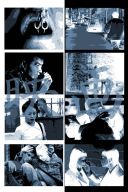| eiga |
|
 | |||||||||||||||||||||||||||
kim ki-duk i cinemateket: interview | |||||||||||||||||||||||||||||



» Se slideshow... |
ĽSort og Hvid er Samme Farve - Black and White is the Same Colour.ę
click here for the danish version
I had been looking forward with excitement to the press meeting in Cinemateket with one of the most distinguished directors in Korean film. Kim Ki-duk enjoys great recognition throughout Europe, and in the four most recent years he has become a downright festival darling, for instance at the NatFilm Festivalen 2005. Movies like The Isle (2000) and Bad Guy (2002) has accomplished to make movie watchers in most of the world find interest in Korean film in general and Kim Ki-dukís work in particular. A quiet Tuesday morning five journalists appeared in Cinemateket to meet with the director and hopefully to become more insightful towards his work. In the room there were tables shaped in the form of a horseshoe, and Kim Ki-duk sat at the end of it. He looked very young and relaxed in a t-shirt, cap, and baggy pants. He radiated peace and a kind casual accommodating attitude which made the whole event seem more like a cosy chat at a cafť than an official press meeting. Eiga: Why did you establish your own production company (Kim Ki-duk Film)? Kim Ki-duk: I gradually felt a pressure to change my movies in a certain direction, which I wouldnít or couldnít relate to purely artistic. My movies arenít topping the box office and the company LJ Film would like to change this fact. They came up with different suggestions about for instance using famous actors for the roles, but it doesnít fit the kind of movies, I make. With my own company, I have complete artistic freedom and donít need to work out a compromise. Itís also an advantage to have control over the economy because then I make more money (laughs). But on the other hand, I also need to find someone who can finance me. The Bow (Hwal, 2005) and 3-Iron (Bin-Jip/Tomme Huse, 2004) are both made with Japanese money. Anyway, the primary reason for why I established my own production company was the fact that I wished more artistic freedom. Eiga: Where is Korean film headed now? Do you see any specific trends at the moment? Kim Ki-duk: Well, I donít know really whether thereíre any. At the moment thereís a lot of awareness toward Korean film but actually I think itís because itís just that time of the year (laughs). At first everybody had interest in Hong Kong, then Japan, and now Korea. Next year maybe itís Thailand. My own movies arenít very popular in Korea. Only about 30.000 saw 3-Iron. That movie was better accepted in Europe and Canada. Most Korean people donít get my movies, nor does the critics. Either they think the movies suck or are trivial. Maybe theyíre right (laughs). I donít have any opinion myself, whether my movies are good or bad. Theyíre sort of a snapshot of my inner self; something I create through my emotions and heart, and thatís the only way I can create movies. By the way, Iíve become gentler through the years. I was very angry when I made my first movie (laughs). Now Iím more interested in understanding people and their reason for acting the way they do, and forgive them. This can result in some scary themes but itís unavoidable when youíre dealing with peopleís soul. Eiga: You said it yourself, that your movies are more popular in the foreign countries than at home in Korea. Howís that so? Kim Ki-duk: I believe many Korean people have difficulties with understanding my movies. Maybe itís because theyíre more infused with European movie tradition than the Asian one. All of South East Asia has a totally different background and culture than Europe, and it can be difficult to realize each others expressions. I donít think that movies should moralize, and therefore things are never entirely simple and straightforward in my own ones. Black and white is the same colour, do you understand? Nothing is absolute. Nothing is only good or only evil. Human beings, who do evil in one way, maybe act caring and good in another way. Everybody contains those two elements, and thatís why people in my movies are switching between good and evil. Sometimes the colours change place so white becomes black, and the other way around. I try to show people and their emotions as objectively as possible. Itís not my decision, whether theyíre evil or good. Maybe this twofold-ness is sometimes confusing. Then I must just learn to express myself better, you know (laughs). Eiga: What inspires you? Kim Ki-duk: Before I began making movies myself, I didnít watch a lot of them. But I like the Austrian director Michael Haneke (Funny Games, La Pianiste) immensely, and Lars Von Trier is also able to set thoughts going. In all other instances, itís mostly things which happens in my own or others life, that inspires me. I also make use of my cultural background. Even though Iím myself a Christian, my cultural roots are in Korea you see, and itís a country of Buddhism, so the philosophy and ideas of Buddhism certainly has influence on my movies. Then again it probably fits together with that good and evil are alike, or more precisely, that itĎs two pages in the same book. I attempt to convey this stuff in my movies in different ways. When thereís so little dialogue in for instance The Isle, then itís because I donít want to interfere with the audienceís opinion of the movie. They can then fill out the missing dialogue or interpret the silence as they wish themselves. My movies also donít have real endings. Theyíre fragments in the characters lives, and their stories keep evolving, when the movie is over. Thereís also a lot who find my movies offensive or provocative but thatís definitely not on purpose. The movies get tough because I myself have had a tough life and because the people they deal with are in the middle of some conflicts. When for instance thereíre often prostitutes in my movies, itís not because I want to show a realistic depiction of life as a hooker. The prostitute woman becomes a symbol of the encounter between good and evil, and of the arising conflicts. Itís the conflicts I like to describe and which inspires me. Eiga: How does the feature proceed from idea to finished work happen? Kim Ki-duk: I write all the manuscripts myself, so accordingly I donít create remakes. Usually I have several ideas. Then they get written down as a manuscript but itís very flexible. It does almost always change during filming and conversations with actors and others. Thatís probably why they never have a definitive ending. Definitive endings are a very Hollywoodish thing to do, while the Kim Ki-duk method is the other way around (laughs). You see, originally Iím not educated as a director or similar. I have worked at a factory and in the military Ė all in all had a very varied career. When I began painting, I realised that I could express myself much better in movies so that was that artistic form I ended up with. In Korea people pay more attention to where you have been going to school and if youíre highly educated. Maybe this is also a reason for why Iím not that popular. Many maybe think Iím not a ďrealĒ director. Making movies the hard way, rewards you in a completely different way. But that doesnít mean that people educated in film schools or university canít make good movies. Certainly not! I just did it differently, is all. The 60 minutes we were given passed on too quickly. The meeting with Kim Ki-duk turned out to be a kind of roundtable conversation, and it has been so exciting and thought-provoking that I could easily have spent much longer time with him. But he had to prepare himself for the evening screening of Samaritan Girl, so I thanked him many times in Korean (ďthanksĒ is called ďgamsahamnidaĒ and is one of the only things I can say in Korean) and leaved Cinemateket, full of thoughts and speculations. Kim Ki-duk is without doubt a director who is capable of setting the train of thoughts going. We can only hope he will keep on making provocative and radically different art-movies. Eiga was also present at the evening event with Kim Ki-duk for the screening of Samaritan Girl. Among other things the director revealed some interesting information about his upcoming movie project after The Bow. The article can be found here. (page 1: danish version) Side 1 2 helene hindberg, 28. september 2005 |
| |||||||||||||||||||||||||||
|
billeder / pictures © copyright
© copyright eiga 2004-2014 : alle rettigheder forbeholdes |
